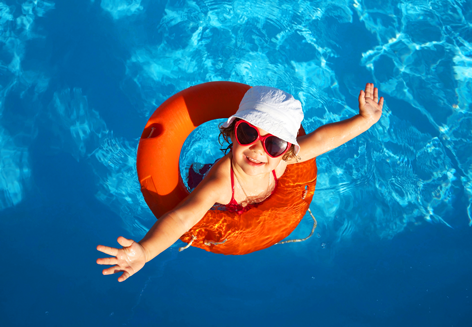Most children don’t learn to swim until they are around five years old. According to the Swiss Lifesaving Society (SLRG), every second child under the age of ten is an unsafe swimmer. These children are dependent on aids. But some swimming aids for toddlers are even dangerous
Swimming aids (learning aids) are divided into three classes:
CLASS A: swim seats and swim trainers (babies and toddlers up to 2 years of age, children who cannot swim).
Experts warn against swimming seats and swimming rings for toddlers. During a safety test, some of the test dummies slipped out of their seats or immediately capsized in the water.
If you use such a swimming aid, then only in direct physical contact with you
CLASS B: Life jackets, swimming discs, swim belts, life jackets or swimsuits (children under 4 years of age).
They are attached to the body, restrict freedom of movement and are therefore not ideal for learning to swim. And they require the child to swim, so they are not suitable for children who cannot swim yet.
Only use such a buoyancy aid in shallow water under adult supervision
CLASS C: swimming boards, swimming noodles (active swimmers from 4 years).
They support swimming and are popular in swimming lessons to improve swimming technique
But be careful: Inflatable toys and rings are NOT a buoyancy aid!
Even if your child is wearing a swimming aid,
DO NOT rely on the safety of a buoyancy aid and ALWAYS supervise your child that air chambers can be defective and therefore no longer work.
Remember that aids that do not fit properly or that do not support your child’s weight can tip your child upside down into the water!
Watch your child when they are sitting in a rubber tire or something similar, because they can drift away.
BUYING TIPS FOR SWIMMING AIDS
Take your time buying buoyancy aids:
Don’t skimp on security, but buy the safer variant, even if it is significantly more expensive.
Are you going on vacation? Plan ahead and buy a tested product BEFORE you start.
Be careful when buying swimming aids online: There are many very cheap but highly questionable aids.
Read the instructions for use and warnings as well as the product information on the packaging before purchasing.
In tests, many swimming aids fail, so pay attention to the markings:
- CE mark (product complies with the health, safety and environmental standards of the EU)
- GS seal of approval (checks for pollution in swimming aids)
- European standard EN 13138-1: 2008 (checks the minimum buoyancy and how fast the air can escape from the valve if a plug is accidentally opened)
- Make sure that the buoyancy aid is suitable for the weight and height of your child. Ideally, you take your child with you and try out the swimming aid in the store.
Swimming aids shouldn’t look like toys. This distracts from their actual function and gives the wrong impression. - When you buy water wings, choose a product with at least two separate air chambers with non-return valves or so-called floating disks made of foam.
- Life jackets put the person in an “unconscious” position in an emergency. This means that the life jacket will keep the child safely above the water even if the child is suddenly unable to move and does not require the child to actively swim.
By the way, inflatable rubber toys etc. are not considered to be buoyancy devices as they do not comply with the necessary safety regulations!
And even if your child is wearing a buoyancy aid, NEVER leave them unattended.
Posted on June 16, 2021 by Luitgard Holzleg
This entry was posted in Blog. Bookmark the permalink.

